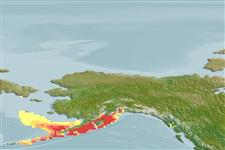Environment: milieu / climate zone / depth range / distribution range
Ecologie
marien demersaal; diepte 69 - 170 m (Ref. 43939). Polar
North Pacific: southeastern Bering Sea and central Aleutian Islands to northern Gulf of Alaska.
Grootte / Gewicht / Leeftijd
Maturity: Lm ? range ? - ? cm
Max length : 7.4 cm TL mannelijk / geslacht onbekend; (Ref. 43939)
Korte beschrijving
Morfologie | Morfometrie
Dorsale stekels (totaal): 6 - 7; Dorsale zachte stralen (totaal): 10-11; Anale stekels 0; Anale zachte stralen: 9 - 10. Head and body covered with tubercles smaller than pupil, some with rosettes of short spines protruding and others concealed, forming bumps. Few or no spiny tubercles on throat. First dorsal fin covered with thick skin (Ref. 43939).
Found on sand, broken shell and gravel bottoms (Ref. 43939).
Levenscyclus en paargedrag
Maturiteit | Voortplanting | Paaien | Eieren | Fecunditeit | Larven
Mecklenburg, C.W., T.A. Mecklenburg and L.K. Thorsteinson, 2002. Fishes of Alaska. American Fisheries Society, Bethesda, Maryland. xxxvii +1037 p. (Ref. 43939)
Status op de Rode Lijst van het IUCN (Ref. 130435)
Gevaar voor de mens
Harmless
Gebruik door de mens
Meer informatie
Lokale namenSynoniemenMetabolismePredatorenEcotoxicologieVoortplantingMaturiteitPaaienPaaiaggregatiesFecunditeitEierenOntwikkeling van de eieren
Leeftijd/GrootteGroeiLengte-gewichtLengte-lengteLengtefrequentiesMorfometrieMorfologieLarvenLarvale populatiedynamiekRekruteringAbundantieBRUVS
ReferentiesAquacultuurAquacultuurprofielKweeklijnenGeneticaElectrophoresesErfelijkheidZiektesVerwerkingNutrientsMassaconversie
Tools
Speciale rapporten
Download XML
Internetbronnen
Estimates based on models
Preferred temperature (Ref.
123201): 3.4 - 5.7, mean 4.4 °C (based on 49 cells).
Fylogenetische diversiteitsindex (Ref.
82804): PD
50 = 0.5000 [Uniqueness, from 0.5 = low to 2.0 = high].
Bayesian length-weight: a=0.02089 (0.00774 - 0.05639), b=3.03 (2.79 - 3.27), in cm total length, based on LWR estimates for this (Sub)family-body shape (Ref.
93245).
Trofisch niveau (Ref.
69278): 3.2 ±0.4 se; based on size and trophs of closest relatives
Weerstandsvermogen (Ref.
120179): Hoog, minimale populatieverdubbelingstijd minder dan 15 maanden (Preliminary K or Fecundity.).
Fishing Vulnerability (Ref.
59153): Low vulnerability (10 of 100).
